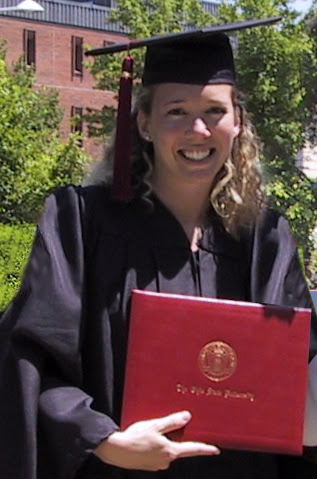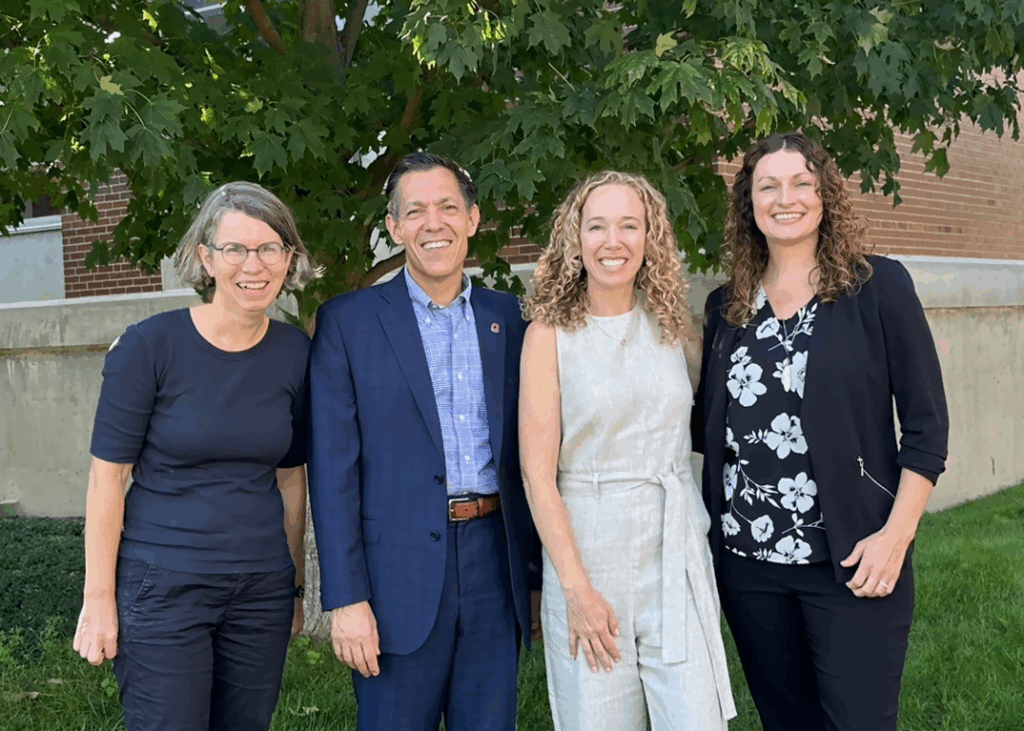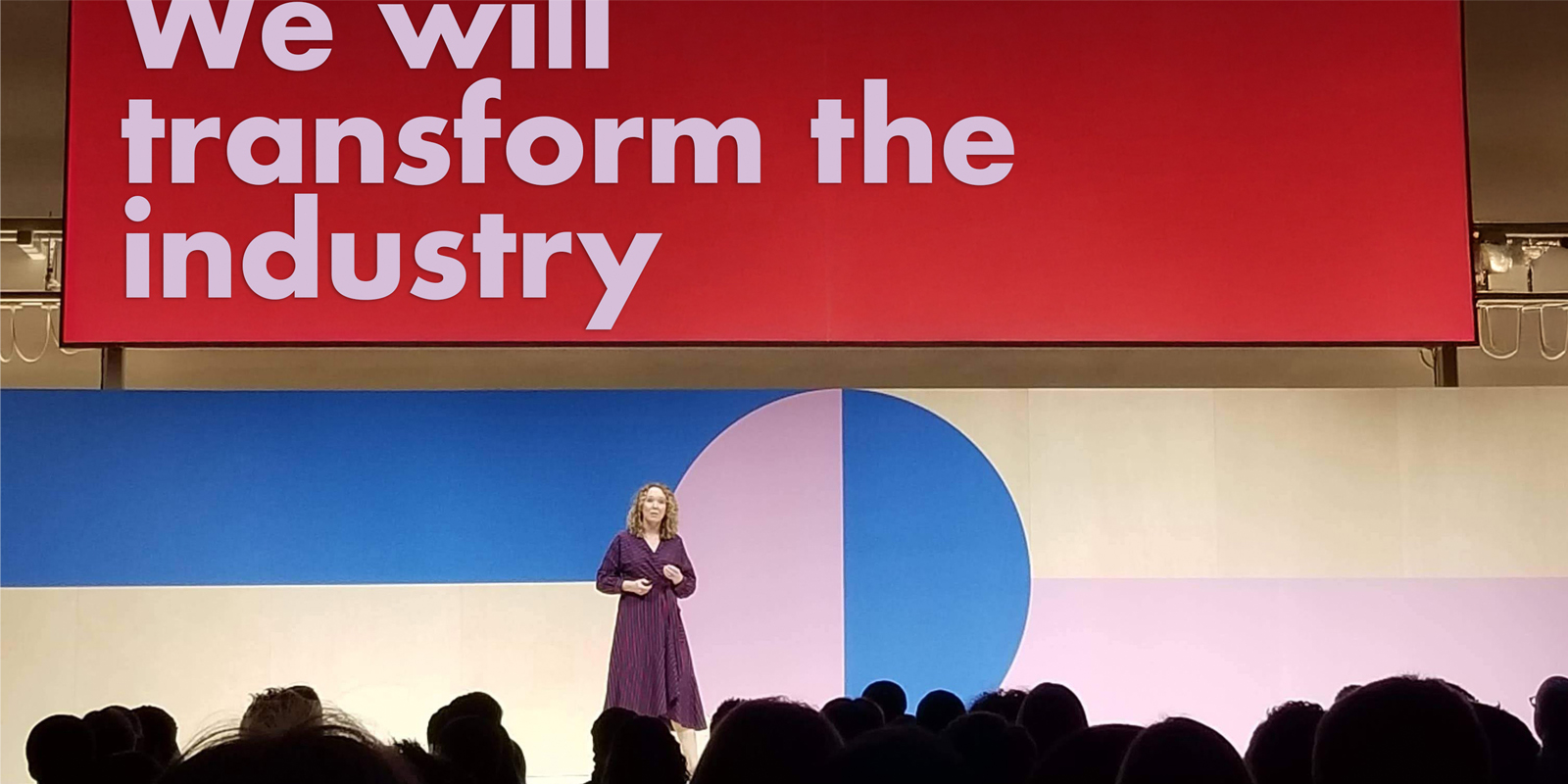Amanda Goodspeed developed a philosophy while studying at Ohio State. It’s good advice for many: “Don’t focus on a job title or where you want to work,” she said. “Focus on your passions and what fuels you.”
With this approach, she ultimately drove the rebranding of a social media giant. She changed how 4 billion people worldwide felt about the major company and its many high-tech products.
She revolutionized how the technology industry experiences advertising.
Her team won 88 major awards in a single year — culminating in being named Agency of the Year by the world’s top creative festivals.
She serves on the Host Committee of the inaugural National Arts Advocacy Summit, joining 50 national leaders across business and entertainment to shape a bold blueprint for advancing the impact of the arts for our country.

In the past two years, she has met with members of Congress and the White House to advocate for increased federal arts funding and public arts education.
She has been a speaker at the Cannes Lions International Festival of Creativity, the Influencers Conference and the Association of National Advertisers.
Her innovative leadership and exceptional business acumen have earned her accolades from leading publications and organizations, including Adweek, Campaign US, D&AD and Women We Admire.
And it all began when an ambitious student with big ideas came to Ohio State to study resource management and computer science.
Anchor yourself in what feels meaningful
At Ohio State, Goodspeed wanted a major that wouldn’t lock her into a narrow job description. Rather, she sought a degree pairing that would engage her in something needed in the world.
Her analytical mind found writing computer code intriguing. Computer Science became one of her focus areas, but she needed more.
She explored Consumer Affairs and Resource Management (now a graduate program) — focusing on studying consumers, their decision making and consumption patterns.
“I was struck by how technology can change a consumer’s experience,” she said, “and I was inspired to be part of that change. We always need ideas that make a company, a brand, the world, better.”
Think of a college major in an expansive way
Managing resources — human, financial, material — “is core to all successful efforts,” Goodspeed said.

“In a company, or a team, or a family, there is a need for community, support, conflict management, shared values and loyalty. Success calls for managing multiple variables to build a successful outcome.”
Her mentor, Faculty Emerita Golden Jackson-Mergler, encouraged her to think outside of what might be defined for her. What the world needs, Goodspeed learned from her professor, is people who understand people and can innovate.
“Think of a college major in an expansive way,” Goodspeed said. “A degree can give you the skills and experience to find work in multiple areas. Think about the expertise you’re gaining and how you can make lives better.”
Goodspeed’s two computer programming internships during college introduced her to the corporate world and built her resume. After she graduated, Sapient hired her as a computer consultant. They staffed her in San Francisco.
Practice resilience, gain perspective
Culture shock describes Goodspeed’s initial time in California. “Even small moments, like discovering new foods and navigating a fast-paced city, helped me to learn that growth happens when you immerse yourself fully in the unfamiliar.”
Her team worked hard building an online stock trading company — which never launched. The 2001 dot com recession made it irrelevant.
“My first job out of college was cancelled,” she said. “It was a pretty big setback.”
But Goodspeed refused to give up. Thanks to her programming experience, Sapient placed her in testing labs. She guided developers in running multiple scenarios to test and retest complex code.
“It taught me the importance of thinking through scenarios from every angle. … How could I think through all the possibilities? I’m known for that in my leadership to this day.”
Pursue what fuels you — and helps others
Soon she found a new opportunity in a seemingly unrelated field: advertising. The industry needed people who could use computer technology to capture consumer interest.
It was the new digital era, and Goodspeed would combine her computer science and consumer insights to help lead companies forward.

She spent six-plus years managing projects for Bay Area advertising agencies. They reached consumers where they were increasingly spending time — online. Ultimately, she served as executive producer for Goodby, Silverstein and Partners, an award-winning agency.
“I feel most successful when my work ties into what fuels me,” Goodspeed said, “which is solving problems for people and businesses.”
She believes people are critical to the resource mix. “There’s so much value in really listening to people,” Goodspeed said. “The more I did that, and I continue to do it in my career, the more successful I’ve been.”
“It’s not imposing what I want, not shaping them into a mold, but recognizing who they are and helping them grow into their own potential.”
See the blank space that no one else sees
Amanda and her team leadership pioneered how tech could elevate storytelling. They were asked to promote Adidas’ new athletic shoes. Her team looked at options from all angles and came up with a groundbreaker: use the 360-degree camera — new on the market and not commonly used by consumers or in advertising.
The result was an eye-popping video showing a panoramic view of Adidas on an NBA athlete. The ad was displayed simultaneously on almost every digital screen up and down the Las Vegas Strip during the NBA All-Star Game.
Goodspeed also led her team in producing a video of the multi-platinum selling rock band Blink-182 and rapper Big Boi. Due to Goodspeed’s leadership, the company reported it was breaking “new ground in fusing music and technology by putting … concerts in the palms of fans’ hands.”
And this was years before the world knew this to be possible.
“My takeaway is always: What’s the blank space or the opportunity that others don’t see?” Goodspeed said. “And going back to my roots in resource management at Ohio State, how can we explore all the possibilities to find the smartest, most human-centered solution?”
Lives and careers are not linear
Sliding back into consulting, Goodspeed contracted with Google to oversee its advertising operations for product launches. She spent several years there, excelling. Then a new opportunity beckoned. She joined Meta in 2017 — not for the title, but for the potential.
“I wanted to be part of something I really believed in,” she said.

What she saw was the chance to build something new at the intersection of creativity, product and business strategy.
“Challenges come in different shapes and forms for everyone,” she said, “but one of the most important things I learned is that in life, or in careers or relationships, it’s not a linear path. So, it’s critical to be agile, to draw on what fuels me, not that job title.”
Back then, most tech companies treated branding and advertising as separate from product development, but Goodspeed believed they could be deeply integrated. She began reading the company’s internal social network each week, following engineering leaders who posted about products they were building from the inside out.
Go beyond the prescribed path
While in the lunch line one afternoon, Goodspeed recognized a senior engineering leader whose post had described a tricky product challenge. “I introduced myself and asked, “What are you hoping your product unlocks for people?”
Thanks to her computer science background, she knew how products were built and functioned. That gave her the ability to follow engineering discussions and translate them into creative opportunities.
“I wasn’t just asking questions — I was tracking his signals for what would matter to people in the world, how we could show up in ways that were meaningful.”
Their conversation opened a door. “I gained insight into how his team was thinking about a product we were preparing to launch,” she said. “I brought that back to shape our creative approach. It helped us better align with what users needed.”
“Other leaders began to see the value of integrating our team earlier in the product lifecycle.”
Over time, this became one of the ways she built credibility — not just by executing great work, but by asking thoughtful questions, building trust and creating meaningful bridges across teams in service of the work, not her team or career.
Lead with vision — and heart
Over seven years, Goodspeed’s role at the company grew exponentially.
“At Meta, the pace was exhilarating and highly innovative. Teams shifted, structures evolved, and priorities constantly adjusted to meet the speed of global culture and emerging tech.”
“I learned to embrace the pace and see change as an opportunity to lead with clarity through complexity. I thrive on the edge of driving change and trying new approaches.”
She started with a 10-person team, and her ability to step in, take ownership and build trust across teams. This led to increasing responsibility, culminating in her leading a global team of more than 650 people across Meta’s brands including Facebook, Instagram, WhatsApp, Reality Labs (Virtual and Augmented Reality) and AI for both Consumer and Business audiences across the world.
“I transformed what started as a small design function into an in-house creative powerhouse that rivaled the best ad agencies in the world,” she said.

Her leadership aligned business priorities, product strategy and brand clarity across one of the world’s most complex platforms.
Her approach was grounded in strategic clarity — ensuring that every project initiative advanced the business in meaningful ways, from product adoption to global brand trust. Her goal wasn’t to create ads — it was to create meaningful impact.
“I’m not a creative by training,” she said to graduate students during a campus visit in autumn 2024. “I’m a builder. I build trust, systems, teams and pathways to growth. Creativity is one tool I use.”
“As an Ohio State graduate and VP, I was proud to sit at the Meta leadership table with our CEO and global leaders across the company. My team led the rebrand from Facebook to Meta. In doing so, we helped shift how creativity was valued in the tech industry.”
They redesigned the Instagram brand for the world. They did the same for Facebook, WhatsApp, Meta Quest (including all retail and package design) and Ray-Ban Meta smart glasses.
“My role was to lead a business unit that connected strategy, product and brand to drive impact at scale. Creativity was the tool. Business transformation was the goal.”
“I had built and scaled a global organization that became essential to how the company launched products, shaped strategy, and built trust with the world.”
With that, Goodspeed was ready for another of her nonlinear career changes.
Get comfortable being uncomfortable
After redefining creativity with innovative technology, Goodspeed turned her attention to early-stage startups—bringing her leadership, operational insight, and brand strategy into the venture world. Last August, Goodspeed joined Menlo Labs, part of a venture capital firm that supports company startups.
As an advisor, she helps early-stage companies shape their strategy, teams, and company from the ground up. “I touch every aspect,” she said, “from the brand and values, the talent and hiring strategy, to the tech, product approach and go-to-market strategy.”

One startup she’s nurturing will shorten the research cycle for hospitals and medical professionals to evaluate life-saving new technology, devices and medicine. Currently, it typically takes years of expensive study and analysis to prove benefits.
“Now, AI can streamline the process,” she said, “ultimately helping people to get the right care, sooner.”
“Every startup I advise is built around AI. I’m still driven by the same curiosity that sparked my career at Ohio State — how technology can change the way people live, work and connect. Staying on the edge of innovation, and now AI, keeps me engaged in shaping not just companies, but how people experience the future.”
And she’s learned that if she’s not uncomfortable, she’s not pushing hard enough.
“I believe growth comes from staying open, staying curious and staying just outside your comfort zone,” she said. “That’s where the future is being built, and I’m excited to help shape it.”

